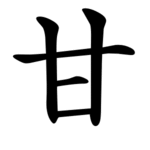

| 甘 | ||||
|---|---|---|---|---|
| ||||
| 甘 (U+7518) "sweet" | ||||
| Pronunciations | ||||
| Pinyin: | gān | |||
| Bopomofo: | ㄍㄢ | |||
| Gwoyeu Romatzyh: | gan | |||
| Wade–Giles: | kan1 | |||
| Cantonese Yale: | gām | |||
| Jyutping: | gam1 | |||
| Japanese Kana: | カン kan (on'yomi) あま-い ama-i (kun'yomi) | |||
| Sino-Korean: | 감 gam | |||
| Names | ||||
| Japanese name(s): | 甘/あまい amai 甘/かん kan | |||
| Hangul: | 달 dal | |||
| Stroke order animation | ||||
 | ||||
Radical 99orradical sweet (甘部) meaning "sweet" is one of the 23 Kangxi radicals (214 radicals in total) composed of 5 strokes.
In the Kangxi Dictionary, there are 22 characters (out of 49,030) to be found under this radical.
甘 is also the 101st indexing component in the Table of Indexing Chinese Character Components predominantly adopted by Simplified Chinese dictionaries published in mainland China.
| Strokes | Characters |
|---|---|
| +0 | 甘 |
| +3 | 𤮾 𤮿 甙 |
| +4 | 甚 |
| +5 | 㽍 |
| +6 | 甛 甜 |
| +8 | 㽎 甝 甞 (=嘗 -> 口) |
| +9 | 㽏 |
| +10 | 㽐 𤯊 |
| +12 | 㽑 |
| +17 | 𤯑 |
甘 [fr; ja; zh] is a Jōyō kanji, or a kanji used in writing the Japanese language.[1] It is a secondary school kanji.[2]
|
Chinese radicals according to the Kangxi Dictionary
| |
|---|---|
| 1 stroke |
|
| 2 strokes |
|
| 3 strokes |
|
| 4 strokes |
|
| 5 strokes |
|
| 6 strokes |
|
| 7 strokes |
|
| 8 strokes |
|
| 9 strokes |
|
| 10 strokes |
|
| 11 strokes |
|
| 12 strokes |
|
| 13 strokes |
|
| 14 strokes |
|
| 15 strokes |
|
| 16 strokes |
|
| 17 strokes |
|
See also: Kangxi radicals | |
|
Simplified Chinese characters radicals (indexing components)
| |
|---|---|
| 1 stroke |
|
| 2 strokes |
|
| 3 strokes |
|
| 4 strokes |
|
| 5 strokes |
|
| 6 strokes |
|
| 7 strokes |
|
| 8 strokes |
|
| 9 strokes |
|
| 10 strokes |
|
| 11 strokes |
|
| 12 strokes |
|
| 13 strokes |
|
| 14 strokes |
|
| 17 strokes |
|
GF 0011-2009 Table of Indexing Chinese Character Components prescribes 201 principle indexing components and 100 associated indexing components (in brackets) used in Simplified Chinese. Not all associated indexing components are listed above. | |